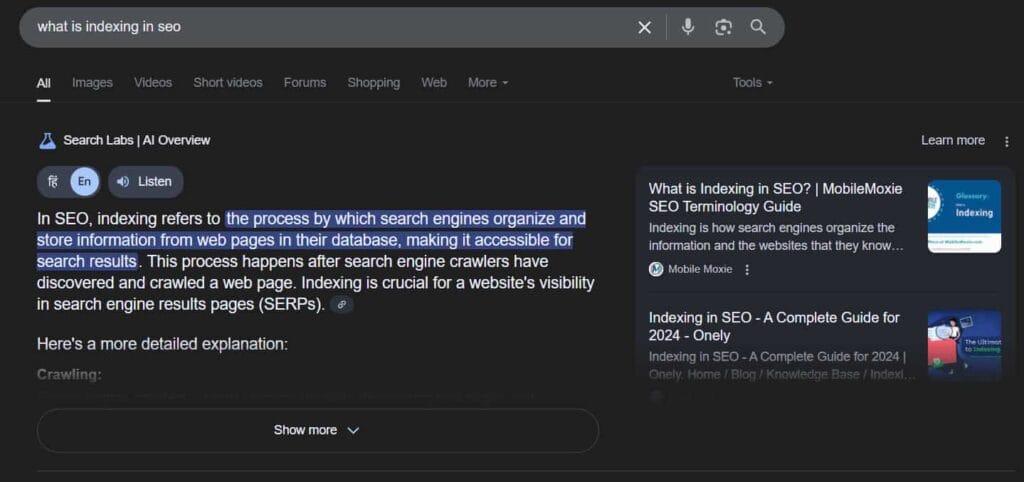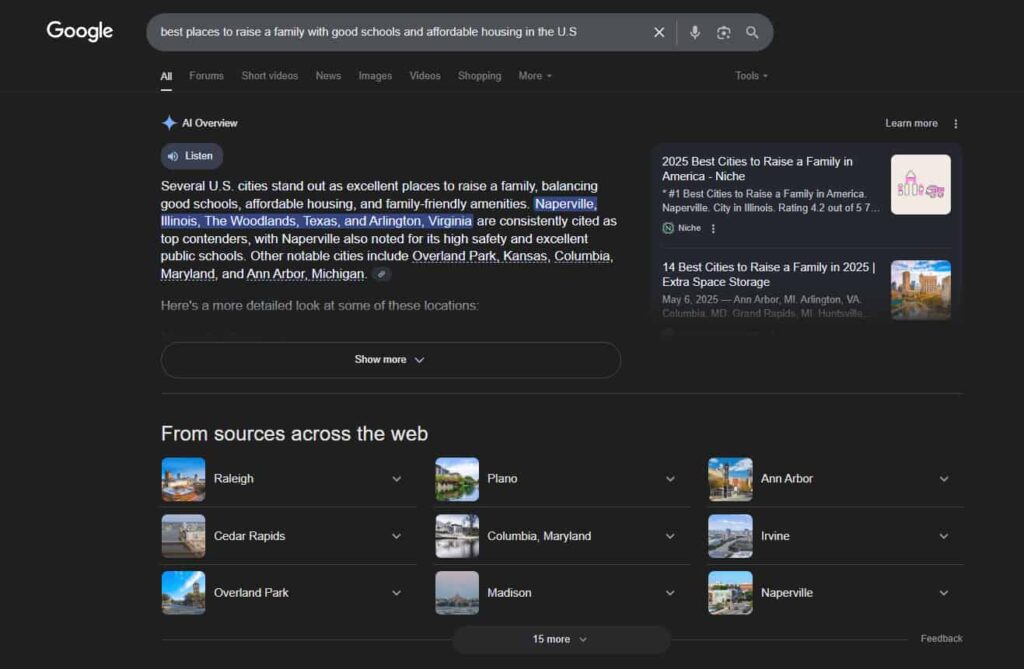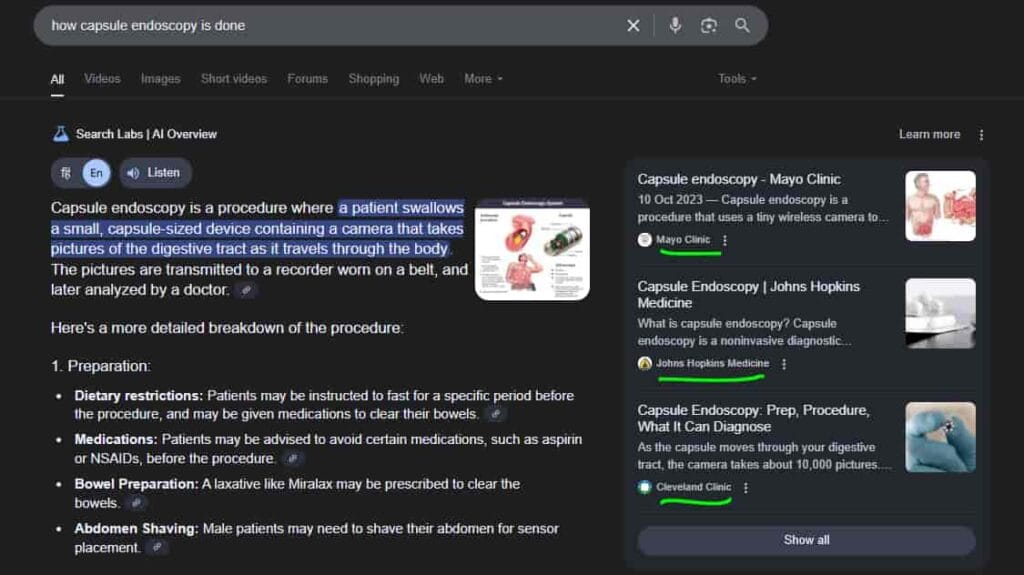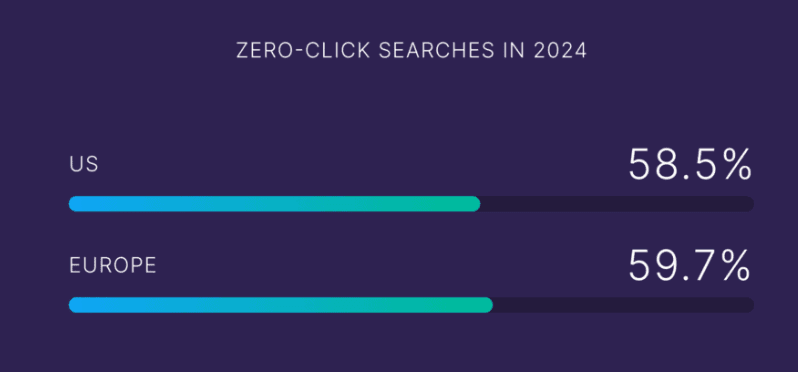Last updated on June 20th, 2025 at 03:36 pm
Understanding and Ranking in Google AI Overviews
Google Search is changing. On May 14, 2024, Google officially introduced Google AI Overviews in the United States. Instead of just showing 10 blue links, this feature displays AI-generated summaries at the top of the results page. These changes affect how users find information.
These summaries are pulled from trustworthy sources; thus, ranking here can drive massive traffic.
Key Takeaways
AI Overviews Show First: These summaries appear before other results and impact your traffic.
Make Your Site Google-Friendly: A well-structured, trusted site ranks better in AI Overviews.
Answer Specific Questions: Focused content that clearly answers one question works best.
Put Simple Answers First: Start with the main point in clear, short sentences.
Link to Wikidata: Connect key terms to Wikidata to help Google understand your content.
Request Reindexing After Updates: Ask Google to revisit updated pages to refresh AI Overviews.
Aim for Top Placement: Try to be the source Google cites first for higher visibility.
Adapt to AI Search: Evolve your strategy to keep up with AI-driven search changes
But how?
In this article, we cover
✔What are Google AI Overviews?
✔How to rank in Google AI Overviews.
✔Why Ranking in AI Overviews Matters
✔How to optimize for AI Overviews
✔ How they differ from SGE (Search Generative Experience)
✔How Do AI Overviews Work?
✔How AI Overviews Affect SEO
✔ Future predictions and expert takeaways
Table of Contents
- Understanding and Ranking in Google AI Overviews
- Key Takeaways
- What Are Google AI Overviews?
- How to rank in Google AI Overviews.
- Why Ranking in AI Overviews Matters
- How to Optimize for AI Overviews
- 1. Prioritize Question-Based Long-Tail Keywords
- 2. Structure for Information Gain
- 3. Use Direct Answer Formatting Early
- 4. Leverage Lists and Clear Headings Extensively
- 5. Strengthen E-E-A-T and Author Signals
- 6. Focus on Top 5 Organic Ranking
- 7. Implement Specific Schema Markup
- 8. Ensure High Content Relevance via Semantic Matching
- 9. Monitor and Adapt to Shifting AI Answers
- 10. Consider Information Density and Conciseness
- How do they differ from the SGE (Search Generative Experience)
- How Do AI Overviews Work?
- How AI Overviews Affect SEO
- Will AI Overviews Kill Organic Traffic?
- How to “Win” with AI Overviews
- Future Predictions and Expert Takeaways
- Conclusions
- FAQ
- 1. How to get featured in AI Overviews?
- Where does AI Overview get its information?
- How to get listed in the Google AI overview?
What Are Google AI Overviews?
When you search on Google, you see a new section at the top of the SERP. This section is often colorful and appears above the traditional blue links.
It always appears at the top of Google Page whether it is (ads), or organic search results.
This is a Google AI overviews. This quick answer is generated by Google’s artificial intelligence model, Gemini.
AI Overviews have been shown in different formats. They can take the form of mini-articles, tables, or lists.
For example, if you look up “what is indexing in SEO,” you will find a summary.

This Google AI overview features link cards—clickable links to the websites referenced in the AI-generated summary. Or offer details on associated topics and questions.
However, AI Overviews are not confined to simple queries. They can also answer difficult, multifaceted questions in one step.
For example, if you search “best places to raise a family with good schools and affordable housing in the U.S.”, the AI Overview checks for a few factors at once:

- Comparison or ranking to determine the “best” options
- Family-friendly cities or towns
- Highly rated public schools
- Affordable housing or cost of living
- Located in the U.S.
Instead of having to search each of these independently, Google AI Overviews provide a comprehensive response that addresses all of these challenges.
It understands and replies to your particular, detailed query, without you having to break it down.
Here is the breakdown of AI overviews:
Structure: AI Overviews provide concise text summaries. They often include hyperlinks to websites. When you click those links, it opens the website where the information is offered.
Interaction: You see a “Show more” option to expand the summary. Below the overview, the familiar organic search results appear.
Sources Link: Whenever you search for anything, it opens the AI overview card at the top, and on the right-hand side, you see the website sources Google uses to present the information.
Google says these sites corroborate the AI’s information.
Some marketers worry about whether the text is original or includes content directly from these websites.
How to rank in Google AI Overviews.
Getting your website featured on Google AI Overviews requires focused SEO work.
You can’t directly affect AI overview rankings because Google creates AIOs on the fly, so content and sources can vary greatly between searches.
Nonetheless, you can improve your chances of getting featured as a source by following these 8 steps:
1. Optimize for Featured Snippets & Top Organic Rankings
Ranking well in traditional organic results is quite beneficial. Websites featured in AI Overviews often rank high on page one. This includes SEO practices:
✅ Optimize the page titles and meta descriptions
✅ Maintain a fast, mobile-friendly website.
✅ Improve the user experience and engagement metrics.
✅ Build a high-quality backlink profile.
✅ Produce useful, reliable, people-first content.
✅ Answer questions directly (short, clear sentences).
✅ Use headers (H2, H3) for easy scanning.
2. Focus Content on Specific Queries
Google AI Overviews tend to favor content that narrowly targets a specific query.
Specificity Over Generalization: Instead of long, comprehensive instructions, provide shorter, more targeted posts that solve specific questions. A precise match in relevance can sometimes outperform a more general article from a higher authority source.
Example:
A 1,500-word guide on “best WordPress plugins” was ignored by AI Overviews.
A 500-word post with a bullet-point list was ranked instead.
Target Informational Keywords: AI Overviews commonly appear for informational queries beginning with (“what,” “how,” “where”, “why,” or “best.”) Identify appropriate question-based keywords for your niche.
3. Optimize Content for AI Overviews
How you structure your content matters the most.
Summarize Clearly: Place a concise summary answering the main question near the top of your page. Use simple sentences and high-readability language. Think subject-verb-object structure.
Plain Language: Avoid jargon and complicated language. Use simple language that Google’s AI can easily understand and potentially use (or “corroborate”).
Google often highlights text from the source page that corresponds to the AI Overview snippet. This text can be quite straightforward and clear.
4. Optimize for Google’s Knowledge Vault
Help Google connect your content to its entity database.

Identify Entities: Identify notable individuals, locations, organizations, or concepts mentioned in your content that are likely to be in the Knowledge Vault (for example, a city, a well-known person, or a specific product).
Link to Wikidata
When mentioning a specific entity, link the term to its corresponding page on Wikidata instead of Wikipedia.
Wikidata is a structured data repository that feeds into Google’s Knowledge Vault, helping confirm exactly which entity you’re referencing.
To do this, search for the entity on Wikidata.org, copy the URL of the correct entity page, and use that as your external link.
5. Align with Core Ranking Signals
Ensure that your website corresponds to Google’s acknowledged ranking parameters.
Review Key Signals: Learn about Google’s documented ranking signals (relevancy, quality, usability, and E-E-A-T).
Google has consistently emphasized high-quality, trustworthy content to help people rapidly find credible solutions to their questions.
AIOs are an extension of this purpose and thus offer authoritative content to increase your chances of being featured.
This is especially crucial for YMYL (Your Money, Your Life) topics, where Google seeks the maximum level of credibility.
For example, if you Google “how capsule endoscopy is done,” you’ll see that the AI overview includes references to the Cleveland Clinic and the Mayo Clinic.

The primary reason for ranking is that such websites follow Google’s E-E-A-T standards. This acronym stands for Experience, Expertise, Authoritativeness, and Trustworthiness, These are the four parameters Google looks for in information to rank it high in traditional organic search results and include it in AIO.
To write content that satisfies these criteria, use these tips.
- Thoroughly research the topic to guarantee its factual accuracy.
- Write thorough responses to people’s inquiries.
- Highlight your areas of expertise to prove yourself as a reputable source of information.
- When possible, provide your unique perspectives and personal experiences.
Optimize holistically: Apply improvements across the entire site to increase performance versus these indications. This strengthens your website’s reputation and eligibility for AI Overviews.
6. Utilize Google Search Console
Accelerate the process of having your changes recognized.
Request Indexing: After optimizing a page for AI Overviews, submit the URL to Google Search Console. This instructs Google to recrawl your page sooner.
Monitor Performance: While Search Console does not segregate AI Overview traffic, monitor your overall organic search performance for changes after optimization.
7. Iterate and Re-Optimize
Ranking in AI Overviews is not a one-time process.
Dynamic Answers: The AI Overview answers can change regularly. An answer you rank now may not be the same tomorrow.
Monitor and Adjust: Regularly check the Google AI Overviews for your target keywords. If the answer changes, review your content. Re-optimize your summary and structure to reflect the updated response properly. After making the changes, resubmit through the Search Console with the URL Inspection Tool.
Persistence Pays: If you don’t rank right away, review the current AI Overview answer again. Refine your content’s opening summary to better align with the information Google is providing. Keep trying different phrasings until you find what Google wants to use.
8. Use structured data
Using structured data sends a clear signal to search engines. It tells them what a page is about without confusion.
For example, if a page shows a product, structured data points out its name, price, and stock status.
This helps search engines read the page faster and show better results. It also improves how your content appears in search, which can bring more clicks.
By adding structured data, you remove the guesswork. Search engines don’t need to figure things out—they see the facts. This simple step can make a big difference in how your site performs.
Free tools like the Structured Data Markup Helper let you build structured data fast. You pick a format, fill in the details, and the tool gives you the code.
You can create markup for recipes, products, FAQs, or blog posts. Choose the type that fits your page.
Make sure the data matches what users see. Clear and correct markup helps search engines read your content better.
It also improves how your site shows up in searches. This small step can help your pages stand out.
Why Ranking in AI Overviews Matters
Google AI Overviews represent a significant shift in search. They change how users interact with results pages. This directly impacts website owners and marketers:

- Visibility: Appearing in the AI Overview section places your content prominently. It’s often the first information a user sees.
- Traffic Potential: Google claims linked websites in AI Overviews receive more clicks than traditional organic results. However, verifying this is difficult. Google Search Console doesn’t currently separate Google AI Overview clicks from regular organic clicks.
- Competitive Landscape: If your competitors appear in AI Overviews and you don’t, you might lose visibility and traffic. The incentive for users to scroll past the AI summary and click traditional links might decrease.
- Direct Recommendations: Google AI Overviews can sometimes recommend specific products or businesses directly within the search results. This offers a powerful way to reach potential customers before they even visit a website.
Ignoring AI Overviews is not an option. Adapting your SEO strategy is necessary to stay competitive in this evolving search landscape.
YOU MAY ALSO LIKE: How to Enable and Use Google AI Mode
How to Optimize for AI Overviews
1. Prioritize Question-Based Long-Tail Keywords
Recent search analyses show AI Overviews appear very often for question-formatted keywords (like “how,” “what,” and “why”) and long-tail searches (queries with four or more words).
(Keyword.com, Cressive DX studies highlight this pattern). Focus content on providing deep, specific answers to these complex queries.
2. Structure for Information Gain
Content that offers unique insights or adds significant value beyond what is commonly available tends to perform well. (Keyword.com emphasizes this).
Ensure your page provides comprehensive information that satisfies user intent more thoroughly than other sources.
3. Use Direct Answer Formatting Early
Google AI seems to favor content that provides a clear, concise answer to the main query very early, often in the first few paragraphs.
(Multiple SEO analyses, including SE Ranking and Writesonic, point to this.) Place straightforward summaries or key takeaways at the beginning of your articles.
4. Leverage Lists and Clear Headings Extensively
Data indicates a high percentage of AI Overviews incorporate lists (bulleted or numbered). (SEOwind research notes lists appear in approximately 78% of Overviews).
Add clear H2/H3 headings for sections and use lists for steps, features, or related points to make content easily scannable for both users and AI.
5. Strengthen E-E-A-T and Author Signals
While always important, demonstrating Experience, Expertise, Authoritativeness, and Trustworthiness is critical for AI Overview inclusion.
(Search Engine Journal, Single Grain, and The HOTH highlight this). Include clear author bios with credentials, cite credible external sources, and ensure factual accuracy.
6. Focus on Top 5 Organic Ranking
Studies by Cressive DX and others show that nearly all AI Overviews cite sources ranking on the first page of Google, with a significant preference for those in the top 5 positions.
A strong foundational SEO strategy is essential to achieving high rankings.
7. Implement Specific Schema Markup
While general structured data is good, consider using more specific schema types like the FAQ schema for question-based content and Article schema for informational pieces.
(SE Ranking, Search Engine Journal suggests this). This helps Google AI better understand the context and purpose of your content elements.
8. Ensure High Content Relevance via Semantic Matching
Content that closely matches the semantic meaning of the AI-generated summary is more likely to be cited. (A study by Botify and DemandSphere touched on this with cosine similarity analysis.)
Understand the nuances of the language AI Overviews use for a topic and align your content’s wording and concepts closely.
9. Monitor and Adapt to Shifting AI Answers
Google AI Overview content is dynamic and can change. Regularly monitor the AI Overviews for your target keywords and be prepared to adjust your content structure or summaries to realign with what Google’s AI is currently favoring.
10. Consider Information Density and Conciseness
AI tools need to synthesize information efficiently. Content that presents facts and answers in a dense but highly readable and concise way, without fluff, is often preferred. Make every sentence count.
How do they differ from the SGE (Search Generative Experience)
| Feature | AI Overviews | SGE (Old Test Version) |
|---|---|---|
| Follow-up Questions | ❌ No | ✅ Yes |
| Local Searches | ❌ Rarely shown | ✅ Often shown |
| Financial Queries | ❌ Avoided | ✅ Included |
| Dynamic Answers | ✅ Updates frequently | ❌ Static |
Google is more cautious with AI Overviews, avoiding sensitive topics (finance, health, legal advice).
How Do AI Overviews Work?
Understanding the mechanics of Google AI Overviews helps you optimize your content. Google employs numerous components to build these summaries.
AI Overviews use a fine-tuned version of Gemini, Google’s language model. They work with tools like the Knowledge Graph and ranking systems to show short, AI-generated responses.
You might spot these results during searches where Google thinks quick answers can help. Right now, they appear in limited cases, but their reach will likely grow.
We’ve seen them show up for different search intents, covering both questions and general topics, including:
1. Informational queries explain something. People ask them to understand how things work or what things mean. For example, “Which animals hibernate during summer?” These questions focus on facts and help users learn quickly.
2. Question-based queries begin with words like what, why, how, when, or where. A typical one could be, “How long do butterflies live in the wild?” These searches show clear intent and often point to curiosity or a need for guidance.
3. Planning queries help users simply arrange ideas or tasks. Someone might type, “3-day itinerary for a solo trip to Jaipur.” These requests often relate to schedules, goals, or step-by-step advice.
4. E-commerce queries point to a buying decision. They often include product names or features. A person may search, “ergonomic office chairs with back support.” These queries usually show the user is ready to compare or purchase.
How AI Overviews Affect SEO
AI Overviews now show quick answers near the top of search results, much like featured snippets or local listings with a map.
These short responses often solve the user’s query without them clicking a link. As a result, more searches may end without visiting a website.

This shift brings challenges, but also fresh chances. Brands that change their approach can still gain attention. Clear answers and strong page structure help you stand out.
You might not always get the click, but you can still earn trust and stay top of mind.
As Tim Cameron-Kitchen from Exposure Ninja points out.
Those who adjust early may see better results. Instead of fighting the change, use it to show your value in fewer words.
Google says AI Overviews are helping more users visit the linked pages. Some in the SEO space still question that claim.
The biggest worry is that AI might pull answers from websites but skip giving credit. There’s also concern about how much traffic site owners could lose if users get what they need without clicking through.
This feature is still fresh. Google keeps adjusting it. The display, the layout, and the links—it’s all moving fast. Nothing feels settled yet.
Even so, the search community knows how to deal with shifts. We’ve handled updates, filters, and penalties before. We didn’t give up. We studied the pattern. We kept going.
If you focus on clarity and match your content to what people ask, you may still win clicks. Maybe fewer in number, but better in quality. And that kind of traffic stays longer, reads more, and buys more.
Will AI Overviews Kill Organic Traffic?

Google Says AI Overviews help drive more visits to listed pages. But you can’t measure those clicks on their own—they blend into regular traffic in Search Console. And if people already see the answer, they may not feel the need to click at all.
What’s next? Google plans to roll this out across more queries. Ads may show up inside these summaries too.
If that hurts traffic, some site owners might speak out. But until that happens, ignoring AI Overviews could cost you visibility.
Right now, the smart move is to write clear, useful content that earns a spot in these summaries. It’s not about chasing trends—it’s about staying seen.
How to “Win” with AI Overviews
Ranking is one goal. Maximizing the benefit is another.
1. Become a Primary Source: Aim to be one of the first websites linked in the Google AI Overview, especially in the first paragraph. These links are often visible by default when the page loads.
Users are more likely to click these initial links if they seek more context. Focus your optimization efforts on matching the content presented in that crucial first paragraph.
2. Get Your Products/Services Recommended: The ultimate win is having your business, product, or service directly mentioned or recommended within the Google AI Overview.
For example, an AI Overview about “best running shoes for flat feet” might list specific shoe models. If you sell one of those models, you gain direct visibility in the search results.
This requires content that establishes your product/service as a top solution for relevant queries, often by being cited in authoritative articles that Google references.
Future Predictions and Expert Takeaways
The introduction of AI Overviews marks a significant step in Google’s vision for search.
1. Expansion Potential
While currently limited in some ways (e.g., no follow-up questions, fewer triggers for certain query types), Google may expand AI Overview capabilities over time, potentially reintroducing features tested during the SGE phase.
Optimizing now prepares you for future enhancements.
2. Accuracy Challenges
AI Overviews have faced criticism for generating incorrect or bizarre information. Google will likely work to improve accuracy over time, but expect ongoing adjustments and corrections.
3. Publisher Concerns
The practice of summarizing information directly on the results page raises questions about website traffic attribution and potential copyright issues.
Google frames the linked sites as “corroborating,” not “sourcing,” the AI answer, but the line can seem blurry. The long-term impact on publisher traffic remains a key concern.
4. Adaptation is Key
Change is constant in SEO and digital marketing. AI Overviews are the current evolution. Marketers must adapt their strategies to leverage this feature for visibility and traffic, rather than resisting the change.
Staying informed and agile is crucial.
Conclusions
Google AI Overviews are here to stay, reshaping the search results page. While they present challenges, they also offer significant opportunities for visibility and traffic.
By understanding how AI Overviews work and implementing targeted optimization strategies, you can position your website at the top of Google Search Engine Result Pages.
Focus on creating clear, helpful, and specific content that directly addresses user queries. Optimize it technically for AI understanding. This approach will help you capture attention and traffic from Google AI Overviews.
FAQ
1. How to get featured in AI Overviews?
Where does AI Overview get its information?
How to get listed in the Google AI overview?
2. Add clear sources to support your content.
3. Write short, direct answers near the top.
4. Use structured data to highlight key info.
5. Update content that already ranks well.
6. Request reindexing in Google Search Console after changes.
Thank you for reading this post, if you have any problem leave you problems in the comment section. And don't forget to subscribe!
